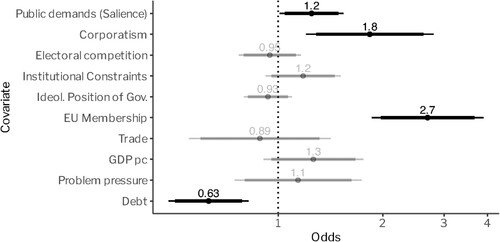Figures & data
Figure 2. Determinants of environmental policy growth. Note: Our analysis covers 21 OECD countries over a period of 45 years (1976–2020). Note that all parameters are standardised to half a standard deviation and can therefore be roughly interpreted as the effect of an increase in one interquartile range; binary (EU) and continuous variables’ (all other) effects are directly comparable.

Figure 3. Determinants of environmental policy growth (disaggregated by instrument type). Note: Our analysis covers 21 OECD countries over a period of 45 years (1976–2020). Note that all parameters are standardised to half a standard deviation and can therefore be roughly interpreted as the effect of an increase in one interquartile range; binary (EU) and continuous variables’ (all other) effects are directly comparable.

Supplemental Material
Download PDF (1.7 MB)Data availability
All data and replication files is accessible via the following link: http://xavier-fim.net/articles/jepp-2024.


